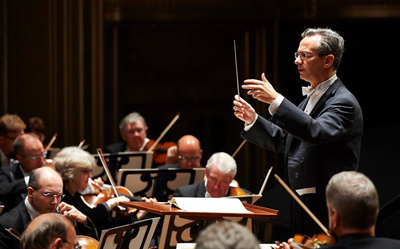by Daniel Hathaway

Liszt broke several shovels full of new ground in his piano concertos. The second begins with lovely conversations between the soloist and the wind section before moving in the direction of keyboard wizardry, transmogrifying its original themes into new shapes and forms as the piece unfolds.
The concerto had a powerful advocate on Thursday evening in French pianist Jean-Yves Thibaudet, whose easy strength and calm virtuosity displayed Liszt’s music in its most attractive light. Every virtuosic gesture had a rhetorical purpose, and even the composer’s shameless, full-keyboard glissandos at the end sounded full of musical import.
Conducting with the flexible precision that is his trademark, Fabio Luisi drew supple and colorful playing from the ensemble while mirroring Thibaudet in his every move. The communication between conductor and soloist was beautiful to watch. Beautiful to hear were the wind solos and principal cellist Mark Kosower’s long, lyrical contribution to the slow section of this single movement piece.
The evening began with a stage full of musicians and equipment. Seven percussionists circled the rest of the orchestra, supplemented by piano, harp, celesta and extra winds for Lucca Francesconi’s Cobalt, Scarlet: Two Colors of Dawn. The piece began with barely audible tinkles and ended the same way twenty-five minutes later. In between came waves of orchestral sound mitigated by quieter passages. The piece was interrupted three times by the martial sounds of snare drums coming from all corners of the percussion section.
Though the program noted that Francesconi is known for his prowess in orchestration, his writing for the brass section dominated the texture at most of the louder moments in the piece, completely engulfing the winds. Cobalt, Scarlet, which suggested, but according to the composer, never really intended to evoke the dawning sky, was just too long to support its musical material. The Orchestra played it with disciplined commitment, but the percussion section probably had the most fun.
After intermission, Luisi led a taught, animated performance of Beethoven’s immensely popular seventh symphony. Why so popular? Perhaps because of its rhythmic vitality and general sense of cheerfulness, even in the slow movement, which Luisi wisely refused to turn into a dirge.
Luisi intriguingly linked the first two movements by moving directly from the first movement into the Allegretto. The scherzo, as persistently repetitive as anything Beethoven ever wrote, bounded merrily along on the strength of its internal energy, its dynamic contrasts and the fine playing of the wind section. The finale, with its unusual theme (the one with the uptick at the end) can sometimes seem endless, but Luisi’s brisk tempo allowed it to fly along swiftly without sounding reckless.
Two out of the three works on tonight’s program were resounding successes. It seems odd that the following evening’s shortened “Fridays@7” program included the Francesconi but not the Liszt.
Photo by Roger Mastroianni.
Published on ClevelandClassical.com March 17, 2015.
Click here for a printable copy of this article



